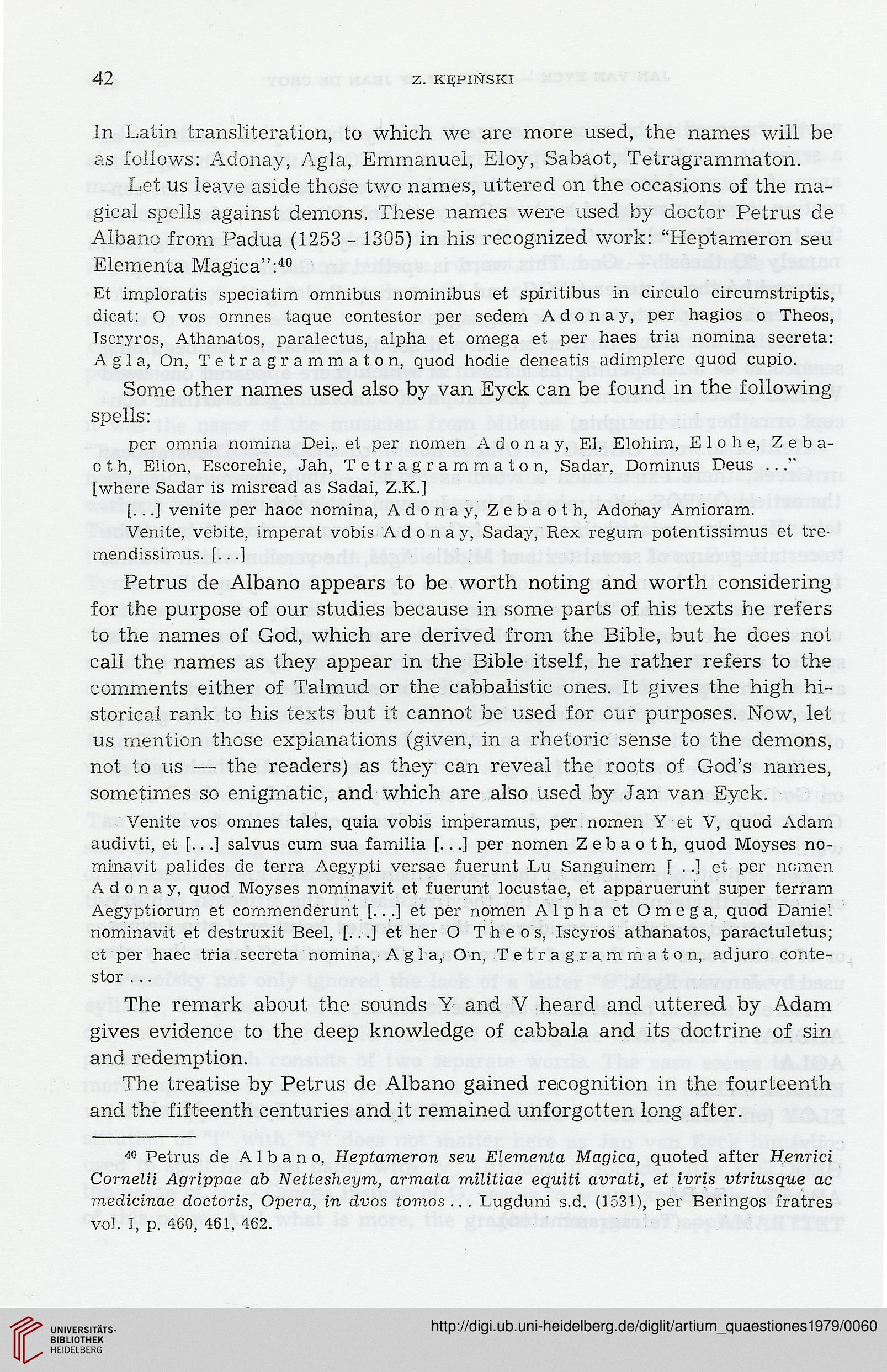42
Z. KĘPIŃSKI
In Latin transliteration, to which we are morę used, the names will be
as follows: Adonay, Agla, Emmanuel, Eloy, Sabaot, Tetragrammaton.
Let us leave aside those two names, uttered on the occasions of the ma-
gical spells against demons. These names were used by doctor Petrus de
Albano from Padua (1253 - 1305) in his recognized work: “Heptameron seu
Elementa Magica”:40
Et irnploratis speciatim omnibus nominibus et spiritibus in circulo circumstriptis,
dicat: O vos omnes taque contestor per sedem Adonay, per hagios o Theos,
Iscryros, Athanatos, paralectus, alpha et omega et per haes tria nomina secreta:
Agla, On, Tetragrammaton, quod hodie deneatis adimplere quod cupio.
Some other names used also by van Eyck can be found in the following
spells:
per omnia nomina Dei,. et per nomen Adonay, El, Elohim, E 1 o h e, Zeba-
o t h, Elion, Escorehie, Jah, Tetragrammaton, Sadar, Dominus Deus .. ."
[where Sadar is misread as Sadai, Z.K.]
[.. .1 venite per haoc nomina, Adonay, Zebaoth, Adonay Amioram.
Venite, vebite, imperat vobis Adonay, Saday, Rex regum potentissimus et tre-
mendissimus. [...]
Petrus de Albano appears to be worth noting and worth considering
for the purpose of our studies because in some parts of his texts he refers
to the names of God, which are derived from the Bibie, but he aoes not
cali the names as they appear in the Bibie itself, he rather refers to the
eomments either of Talmud or the cabbalistic ones. It gives the high hi-
storical rank to his texts but it cannot be used for our purposes. Now, let
us rnention those expłanations (given, in a rhetoric sense to the demons,
not to us — the readers) as they can reveal the roots of God’s names,
sometimes so enigmatic, and which are also used by Jan van Eyck.
Veni te vos omnes tales, quia vobis imperamus, per nomen Y et V, quoa Adam
audivti, et [...] salvus cum sua familia [...] per nomen Zebaoth, quod Moyses no-
minavit palides de terra Aegypti versae fuerunt Lu Sanguinem [ ..] et per nomen
Adonay, quod Moyses nominavit et fuerunt locustae, et apparuerunt super terram
Aegyptiorum et commenderunt [...] et per nomen Alpha et Omega, quod Daniel
nominavit et destruxit Beel, [...] et her O Theos, Iscyros athanatos, paractuletus;
ot per haec tria secreta nomina, Agla, On, Tetragrammaton, adjuro conte-
stor . ..
The remark about the sounds Y and V heard and uttered by Adam
gives evidence to the deep knowledge of cabbala and its doctrine of sin
and redemption.
The treatise by Petrus de Albano gained recognition in the fourteenth
and the fifteenth centuries and it remained unforgotten long after.
40 Petrus de Albano, Heptameron seu Elementa Magica, quoted after Henrici
Cornelii Agrippae ab Nettesheym, armata militiae eąuiti avrati, et ivris vtriusque ac
medicinae doctoris, Opera, in dvos tomos .. . Lugduni s.d. (1531), per Beringos fratres
vol. I, p. 460, 461, 462.
Z. KĘPIŃSKI
In Latin transliteration, to which we are morę used, the names will be
as follows: Adonay, Agla, Emmanuel, Eloy, Sabaot, Tetragrammaton.
Let us leave aside those two names, uttered on the occasions of the ma-
gical spells against demons. These names were used by doctor Petrus de
Albano from Padua (1253 - 1305) in his recognized work: “Heptameron seu
Elementa Magica”:40
Et irnploratis speciatim omnibus nominibus et spiritibus in circulo circumstriptis,
dicat: O vos omnes taque contestor per sedem Adonay, per hagios o Theos,
Iscryros, Athanatos, paralectus, alpha et omega et per haes tria nomina secreta:
Agla, On, Tetragrammaton, quod hodie deneatis adimplere quod cupio.
Some other names used also by van Eyck can be found in the following
spells:
per omnia nomina Dei,. et per nomen Adonay, El, Elohim, E 1 o h e, Zeba-
o t h, Elion, Escorehie, Jah, Tetragrammaton, Sadar, Dominus Deus .. ."
[where Sadar is misread as Sadai, Z.K.]
[.. .1 venite per haoc nomina, Adonay, Zebaoth, Adonay Amioram.
Venite, vebite, imperat vobis Adonay, Saday, Rex regum potentissimus et tre-
mendissimus. [...]
Petrus de Albano appears to be worth noting and worth considering
for the purpose of our studies because in some parts of his texts he refers
to the names of God, which are derived from the Bibie, but he aoes not
cali the names as they appear in the Bibie itself, he rather refers to the
eomments either of Talmud or the cabbalistic ones. It gives the high hi-
storical rank to his texts but it cannot be used for our purposes. Now, let
us rnention those expłanations (given, in a rhetoric sense to the demons,
not to us — the readers) as they can reveal the roots of God’s names,
sometimes so enigmatic, and which are also used by Jan van Eyck.
Veni te vos omnes tales, quia vobis imperamus, per nomen Y et V, quoa Adam
audivti, et [...] salvus cum sua familia [...] per nomen Zebaoth, quod Moyses no-
minavit palides de terra Aegypti versae fuerunt Lu Sanguinem [ ..] et per nomen
Adonay, quod Moyses nominavit et fuerunt locustae, et apparuerunt super terram
Aegyptiorum et commenderunt [...] et per nomen Alpha et Omega, quod Daniel
nominavit et destruxit Beel, [...] et her O Theos, Iscyros athanatos, paractuletus;
ot per haec tria secreta nomina, Agla, On, Tetragrammaton, adjuro conte-
stor . ..
The remark about the sounds Y and V heard and uttered by Adam
gives evidence to the deep knowledge of cabbala and its doctrine of sin
and redemption.
The treatise by Petrus de Albano gained recognition in the fourteenth
and the fifteenth centuries and it remained unforgotten long after.
40 Petrus de Albano, Heptameron seu Elementa Magica, quoted after Henrici
Cornelii Agrippae ab Nettesheym, armata militiae eąuiti avrati, et ivris vtriusque ac
medicinae doctoris, Opera, in dvos tomos .. . Lugduni s.d. (1531), per Beringos fratres
vol. I, p. 460, 461, 462.




